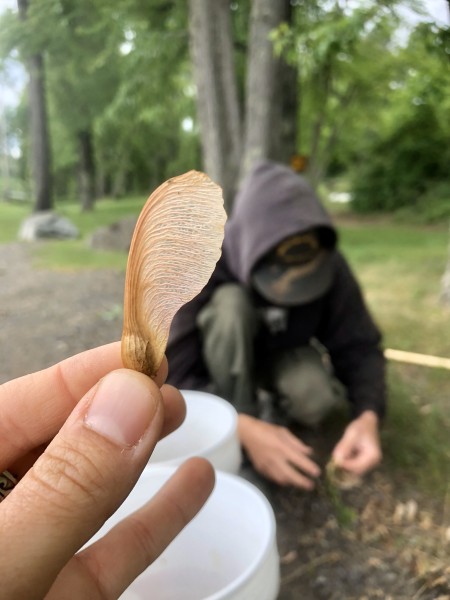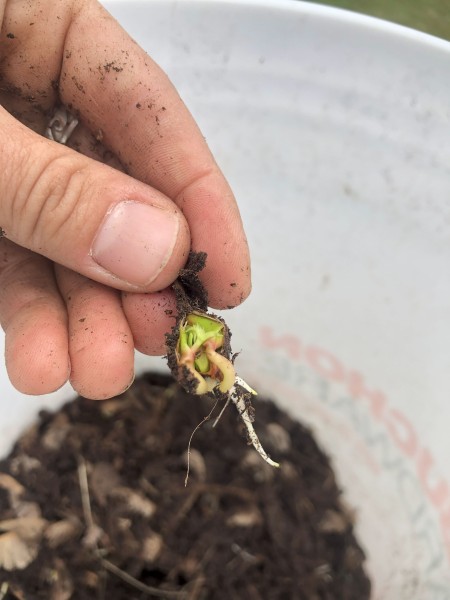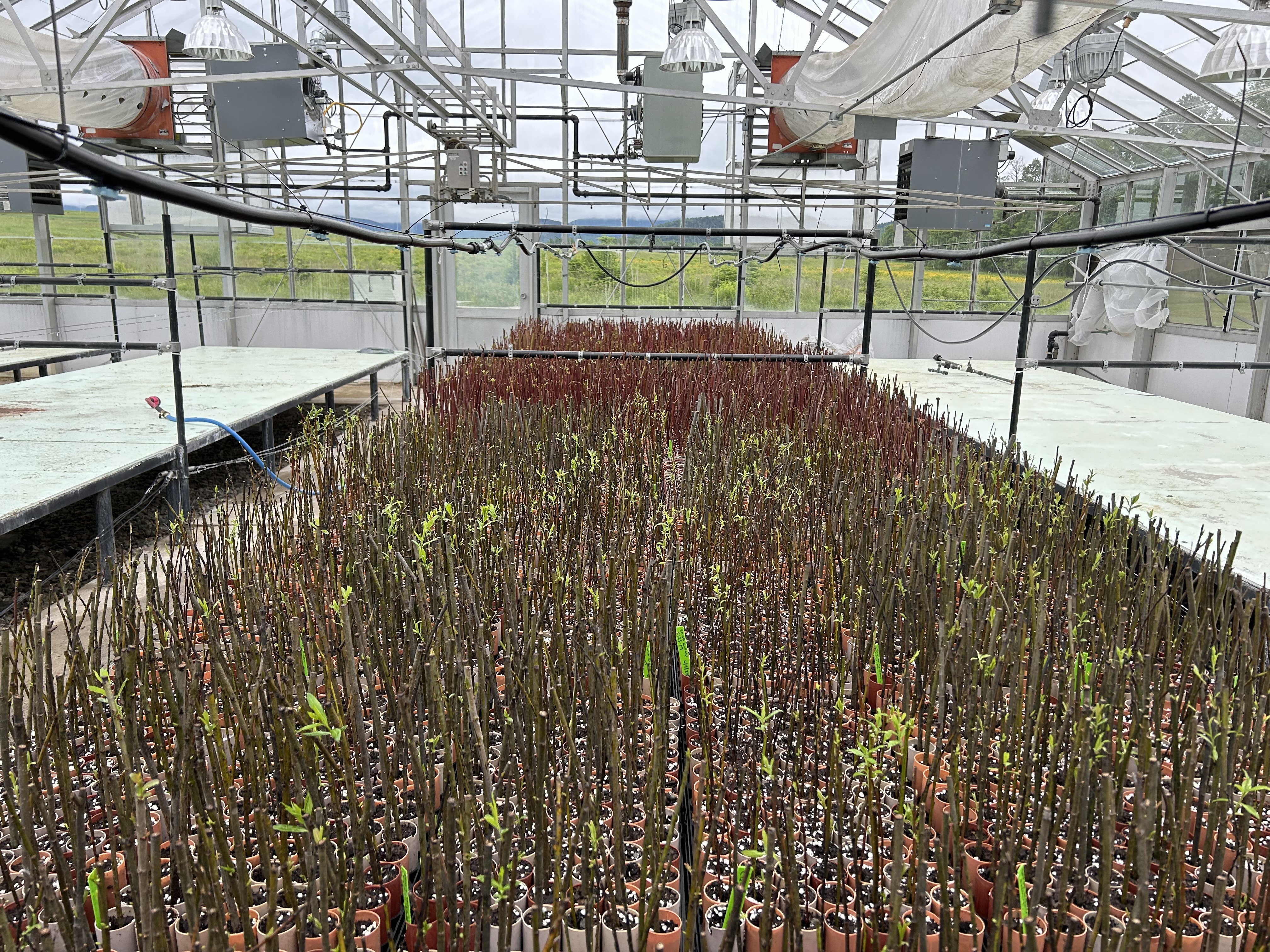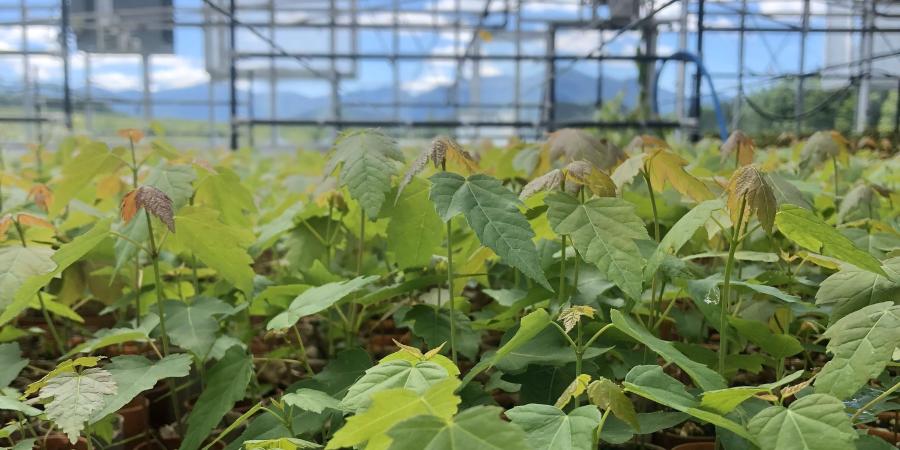Greetings from the Ausable Conservation Nursery! For those new here, we are a native plant nursery dedicated to growing hyperlocal, elevation hardy, woody plants to be used for the restoration of riparian areas throughout the Adirondacks. Our staff devoted much of late spring and early summer to scouting, collecting, and propagating native trees and shrubs from wild-collected seeds and hardwood cuttings sourced from the Ausable River watershed. Red maples (Acer rubrum) and Silver maples (Acer saccharinum) are among the species propagated from seeds. As seeds ripened on the trees, our staff collected mature samaras from both branches and the ground below.

ACN staff collecting Silver maple seed at a site in Keene, NY.
These seeds were mixed with wet peat moss and placed in an incubation room within the greenhouse. After about a week, the seeds began to sprout radicals, which grew into the soil as the first roots.

The root radical of a silver maple seed emerging at the ACN greenhouse.
Staff then sowed these germinating seeds into soil-filled tubes and placed them in the greenhouse.

ACN staff sowing silver maple seeds that have sprouted radicals.
Over the last 6 weeks, the maple seedlings have grown 6-10 inches tall. They are scheduled to be transplanted to the production field in spring 2025, where they will grow for 1-2 seasons before being harvested as bare-root trees.

Silver Maple seedlings after six weeks of growth in the ACN greenhouse.
Additionally, ACN propagated over 14,000 willows and dogwoods from hardwood cuttings. These cuttings were collected in late winter and stored in a cool, dark space until early June. Upon exposure to sunlight, warmer temperatures, and moisture in the greenhouse, they readily sprouted roots and leaves. These cuttings will continue growing in the greenhouse until spring 2025, when they will be transplanted into the production field.

Native Shrub Willow, Silky Dogwood, and Red Osier Dogwood hardwood cuttings that were propagated in the ACN greenhouse in early June.

The progression of the hardwood cuttings after 5 weeks of growth in the ACN greenhouse.
Transitioning from the greenhouse to the production field allows the trees a protected space to acclimate to the Adirondack weather, and facilitates the transformation of soil minerals and nutrients into leaves, stems, and bark. Extensive planning and consideration are dedicated to preparing the field for the arrival of these young trees, as they thrive best in fertile soils with minimal compaction. To maximize soil fertility and implement weed management strategies, ACN staff employs the use of cover crops, which are commercial crops grown to enhance soil structure, reduce pest pressure, and bolster fertility. This practice, similar to methods used throughout generations of agriculture and traditional land management, includes recently planting buckwheat as a cover crop. Buckwheat, known for its rapid growth, is invaluable for rejuvenating worn-out or over-farmed soils. Once mature in mid-August, it will be incorporated into the soil using a mower and rototiller, followed by a planting of winter rye and radishes as fall cover crops.

ACN staff rototilling the production field in preparation for cover cropping buckwheat in late June.
Winter rye, a cereal grain crop, is sown in late summer and harvested the following spring, remaining dormant under snow, stabilizing soil and averting erosion. Radishes, in contrast, grow from late summer until the temperature consistently drops below 25 degrees Fahrenheit, breaking up soil compaction with their long taproots and enhancing water infiltration. By integrating these crops and returning their biomass to the soil, ACN aspires to create an optimal environment for our native tree species to flourish.
With the first growing season fully underway, ACN looks forward to building and growing nursery systems and infrastructure to increase the capacity to produce bare-root stock for AFC's restoration projects. If you'd like to get your hands dirty at the nursery next year, stay tuned to the AFC newsletter for engagement opportunities!
Story by Tully Miller, ACN Technician.
Sign-up for our e-newsletter to get weekly updates on the latest stories from the Ausable Freshwater Center.

